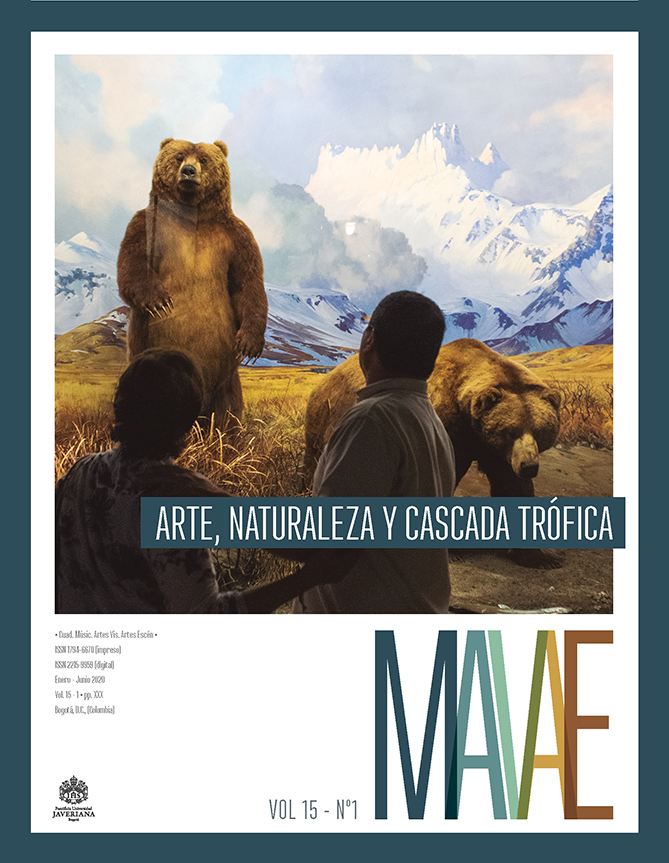To Narrate is to Weave Actions and Desires that Interact with Images
##plugins.themes.bootstrap3.article.details##
La Huerta, a relational art project, first took place in 2004 in Peñas, Municipality of Tinjacá, Boyacá, Colombia. This story presents the scope of the art that promotes sensitive relationships that derives from encounters with a peasant community encouraged to interact sitting around a table placed in an orchard, where the issues addressed allow, through documentation, to create an installation experience with images. The orchard and table, devices that constitute the relational space, refer to a house as a continent that houses memories, practices, narratives and communicative processes of daily life, hence an awareness about the body, the environment and culture. Here, we describe a reflexive observation about the image that, when returned to the actors, structures a trophic turn, mobilized by the recognition of itself in friction with urban incidence in the rural environment. The methodology, guided by the criteria of exchange, reciprocity and circulation of stories, processes and actions, reveals traces, voices, memories and rural customs that inhabit the territory. The collaborative art focused on horticultural practices as structuring axes of the meetings allows operations with photography, audios, videos and texts to draw a horizon of memory and its unconscious, expressed in the portrait and the moving image and show ways of being and inhabiting the landscape; returning an image of oneself to the community constitutes a double chain, which operates reflexivity from experience.
orchard, circulation, exchange, reciprocity, relational aesthetics, collaborative arthuerta, circulación, intercambio, reciprocidad, estética relacional, arte colaborativohorta, circulação, intercâmbio, reciprocidade, estética relacional, arte colaborativa
— 2001. “Notas sobre o gesto”. Artefilosofía 4: 9-14.
Arendt, Hannah. 1996. La condición humana. Barcelona: Paidós.
Belting, Hans. 2007. Antropología de la imagen. Madrid: Katz.
Benjamin, Walter. 2008. “Parque central”. En Obras. Libro I. Volumen 2, 261-302. Traducido por Alfredo Brotons Muñoz. Madrid: Abada.
Becker, A. E. (1995). Body, Self, and Society: The View from Fiji. Pennsylvania: Universityof Pennsylvania Press.
Bourriaud, Nicolas. 2006. Estética relacional. Buenos Aires: Adriana Hidalgo.
Charles-Edwards, T. M. (1993). Early Irish and Welsh Kinship. Oxford: Clarendon Press.
De Certeau, Michel. 1996. La invención de lo cotidiano. Vol. 1: El arte de hacer. Traducido por Alejandro Pescador. México: Universidad Iberoamericana.
Didi-Huberman, Georges. 1997. Lo que vemos, lo que nos mira. Buenos Aires: Manantial.
— 2007. Cuando las imágenes tocan lo real. En Cuando las imágenes tocan lo real, 7-36. Madrid: Arte y Estética.
— 2008. Ante el tiempo: historia del arte y anacronismo de las imágenes. Buenos Aires: Adriana Hidalgo.
Didi-Huberman, Georges. 2010. Ante la imagen. Murcia, España: Centro de Documentación y Estudios Avanzados de Arte Contemporáneo.
— 2014. Pueblos expuestos, pueblos figurantes. Buenos Aires: Manantial.
Francisco. 2015. “Laudato si’”. Consultado el 8 de octubre de 2019. http://w2.vatican.va/content/francesco/es/encyclicals/documents/papa-francesco_20150524_
enciclica-laudato-si.html
Ingold, Tim. 2012. Ambientes para la vida: conversaciones sobre humanidad, conocimiento y antropología. Montevideo: Trilce.
Ochoa Gautier, Ana María. 2004. “Sobre el estado de excepción como cotidianidad: cultura y violencia en Colombia”. En La cultura en las crisis latinoamericanas, compilado por Alejandro Grimson, 17-42. Buenos Aires: Consejo Latinoamericano de Ciencias Sociales.
Rancière, Jacques. 2005. El inconsciente estético. Buenos Aires: El Estante.
— 2011. El malestar en la estética. Buenos Aires: Capital Intelectual.
Sahlins, Marshall. 2015. “Sobre la cultura del valor material y la cosmografía de la riqueza”. Etnografías Contemporáneas 1 (1): 181-226
Taussig, Michael. 2004. “Mi museo de la cocaína”. En Droga, cultura y farmacolonialidad: la alteración narcográfica, editado por Lizardo Herrera y Julio Ramos, 45-65. Santiago de Chile: Universidad Central de Chile.


